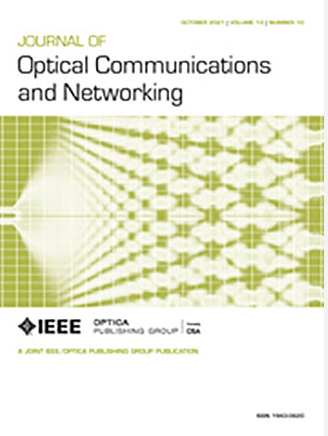灵活速率pon中基于流量感知的ONU分组与组播业务下行带宽分配
IF 4.3
2区 计算机科学
Q1 COMPUTER SCIENCE, HARDWARE & ARCHITECTURE
引用次数: 0
摘要
在灵活速率无源光网络(pon)中,不同信道条件下的光网络单元(onu)通过实现灵活的传输参数(如调制格式)来实现不同的数据速率,从而提高系统容量。相应的,下游帧被分成多个子帧,每个子帧只被目标组中的onu接收和处理。然而,对于下游组播业务,数据需要被复制并封装到多个子帧中,从而导致数据冗余和有效吞吐量(即没有冗余数据的吞吐量)的降低。为了提高资源利用率,ONU分组需要根据信道条件和时变的网络因素(如流量负载和组播成员)进行动态调整。为此,我们首先对现有的下游调度协议进行了改进,使其支持组播场景下的动态ONU分组,并提出了一种流量感知的ONU分组(TAOG)算法来提高有效吞吐量,该算法在考虑时变网络条件的情况下优化了ONU分组。由于不同分组的ONU具有不同的数据速率,我们进一步提出了基于分组的下游时隙分配(GBDTA)算法,根据各业务的需求和ONU的数据速率来调整各业务的时隙。详尽仿真结果表明,该方案能有效适应动态网络环境,在多种组播场景下,与传统方案相比,有效提高了有效吞吐量,减少了冗余,实现了更低的数据包延迟。本文章由计算机程序翻译,如有差异,请以英文原文为准。
Traffic-aware ONU grouping and downstream bandwidth allocation for multicast services in flexible-rate PONs
In flexible-rate passive optical networks (PONs), optical network units (ONUs) with different channel conditions can achieve different data rates by implementing flexible transmission parameters, e.g., modulation format, thereby enhancing system capacity. Correspondingly, the downstream frame is divided into multiple subframes, each being received and processed only by ONUs in its targeted group. However, for downstream multicast services, the data need to be duplicated and encapsulated into multiple subframes for ONUs belonging to different groups, resulting in data redundancy and degradation of effective throughput (i.e., throughput without redundant data). To improve resource utilization, ONU grouping should be dynamically adjusted according to both channel conditions and time-varying network factors, e.g., traffic loads and multicast memberships. For this, we first enhance the current downstream scheduling protocol to support dynamic ONU grouping in a multicast scenario and propose a traffic-aware ONU grouping (TAOG) algorithm to improve effective throughput, which optimizes ONU grouping by considering time-varying network conditions. As ONUs belonging to different groups have different data rates, we further propose a group-based downstream time slot allocation (GBDTA) algorithm to adjust time slots for each service by considering their demands and ONU data rates. Exhaustive simulation results show that the integrated TAOG-GBDTA scheme adapts effectively to dynamic network conditions and, compared to conventional schemes, it effectively improves effective throughput, reduces redundancy, and achieves lower packet latency under various multicast scenarios.
求助全文
通过发布文献求助,成功后即可免费获取论文全文。
去求助
来源期刊
CiteScore
9.40
自引率
16.00%
发文量
104
审稿时长
4 months
期刊介绍:
The scope of the Journal includes advances in the state-of-the-art of optical networking science, technology, and engineering. Both theoretical contributions (including new techniques, concepts, analyses, and economic studies) and practical contributions (including optical networking experiments, prototypes, and new applications) are encouraged. Subareas of interest include the architecture and design of optical networks, optical network survivability and security, software-defined optical networking, elastic optical networks, data and control plane advances, network management related innovation, and optical access networks. Enabling technologies and their applications are suitable topics only if the results are shown to directly impact optical networking beyond simple point-to-point networks.

 求助内容:
求助内容: 应助结果提醒方式:
应助结果提醒方式:


